Anyone who says they have only one life to live must not know how to read a book. ~ Author Unknown
Saturday, October 21, 2006
Dos and don’ts on approaching a publisher
You want the book you’ve written to be published. So how do you set about it? Where will you send the typescript? Probably to a publisher, but to which one? Michael Legat offers guidelines on how to proceed.
Finding a publisher
Do your market research in public libraries and bookshops, and especially inWriters’ and Artists’ Yearbook, to find out which publishers bring out the kind of book you have written. While looking at the Yearbook entries, note which publishers are willing to consider books submitted to them directly, rather than through an agent, and which require a letter of enquiry first. Incidentally, if you are hoping to interest an agent, they almost all want an enquiry letter first.
Enquiry letters
An enquiry letter should be business-like. Don’t grovel (‘it would be an honour to be published by so distinguished a firm’), don’t make jokes (‘my Mum says it’s smashing, but maybe you’ll think she’s prejudiced’), don’t be aggressive (‘I have chosen you to publish my book, kindly send me your terms by return’). It is a good idea to write to whichever editor in the publishing house is responsible for books of the kind you have written (a phone call will provide this information — but take care to get the right title and spelling of the editor’s name). Enclose a stamped addressed envelope. Look at the examples of the two poor enquiry letters followed by a good one on page 239. You may have noticed that none of the letters refers to sending a disk or email. Such submissions may well become standard in a few years’ time, but that stage has not yet been reached. However, once a book has been accepted, the publisher will certainly want a copy of the book on disk if it is available.
Presentation
Assuming that a publishing firm agrees to look at your book, the editor will expect to see a well-presented typescript (sometimes called a manuscript, abbreviated to MS). Here are some dos and don’ts about its appearance. Use a typewriter or a word processor, or get a secretarial service to translate your handwriting on to a disk. Don’t expect a publisher to read a handwritten script, even if you have a fine Italian hand.Choose a good quality white A4 paper (preferably not continuous listing paper, or if you must use it, at least separate the pages and remove the perforated edges). Whatever paper you use don’t type on both sides, and don’t use single spacing (which publishers abhor, and usually refuse to read) — one side of the paper only and double spacing is the rule. And do leave a good margin, at least 3 cm, all around the text, using the same margins throughout, so as to have the same number of lines on each page (except at the beginning and end of chapters). Double spacing and good margins allow space for your last-minute corrections to the typescript, for any copy-editor’s amendments, and for instructions to the printer. And, not least in importance, a typescript in that style is much easier to read.
Always begin chapters on a new page. Justify on the left hand side only. Don’t use blank lines between paragraphs (in the style of most typed letters nowadays), but indent the first line of each paragraph a few spaces. Blank lines should be used only to indicate a change of subject, or time, or scene, or viewpoint. Be consistent in your choice of variant spellings, capitalisation, use of subheadings, etc. Make up your mind whether you are going to use -ise or -ize suffixes, for example, and whether, if ‘village hall’ appears in your text, you will type ‘village hall’ or Village Hall’.For plays, use capitals for character names and underline stage directions or print them in italics. Use single spacing for dialogue, but leave a blank line between one character’s speech and that of the next character to speak. Poetry should be typed in exactly the way that the poem would appear in a printed version, using single or double spacing and various indentations as the poet wishes.
Organising the pages
Number the pages (or ‘folios’, as publishers like to call them) straight through from beginning to end. Don’t start each chapter at folio 1. If you need to include an extra folio after, say, folio 27, call it folio 27a and write at the foot of folio 27: ‘Folio 27a follows’. Then write at the foot of 27a: ‘Folio 28 follows’. Obviously, if you want to insert more than one page, you would use ‘27a’, ‘27b’, ‘27c’, and so on. Some writers like to use part of the book’s title as well as the folio number: ‘Harry 27’, for example, but this is not essential. Create a title page for the book, showing the title and your name or pseudonym. Add your name and address in the bottom right hand corner, and also type it on the last folio of the typescript, in case the first folio becomes detached. You can also add a word count, if you wish (if using the word-counting facility on your word processor, round the figure up or down to the nearest thousand or five thousand). If you want to include a list of your previously published books, a dedication, a quotation, a list of contents or of illustrations, an assertion of your moral rights, or any similar material, use a separate page for each item. Leave these pages unnumbered or use small roman figures — i, ii, iii, etc — so that the first folio to have an Arabic number will be the first page of your text.When fastening the typescript together, don’t use pins (which scratch), paperclips (which pick up other papers from a busy editor’s desk), or staples (which make it difficult to read). Don’t ever fasten the pages together in one solid lump, and it’s best to avoid ring binders too. Don’t use plastic folders — they are slippery and can very easily cascade off a pile on the editor’s desk (which won’t please the editor). Almost all publishers prefer to handle each folio separately, so put the typescript into a wallet-type folder, or more than one if necessary. Put the title of the book and your name and address on the outside of the folder.
If illustrations form a large part of your book and you expect to provide them yourself they should be included with the typescript, and equally a selection should accompany a synopsis and specimen chapters. Send copies rather than originals. If your book is for children don’t complete all the illustrations until the publisher has decided on the size of the book and the number of illustrations. If you have a friend who wants to supply illustrations for your book, do make sure that they will be up to publishing standard before you accept the offer. You may put off a children’s publisher by suggesting an illustrator — they like to choose.
Waiting for a decision
Many publishers take what seems to be an unconscionable time to give a verdict on typescripts submitted to them. However, a decision whether or not to publish may not be easy, and several readings and consultations with other departments in the publishing house often have to take place before the editor can be sure of the answer. If you have heard nothing after two months, send a polite letter of enquiry; if you get no response, ask for your typescript back, and try another publisher.
Don’t expect to be given reasons for rejection. Publishers do not have time to spend on books and authors which they are not going to publish. However, if the rejection letter contains any compliments on your work, you can take them at face value — publishers tend not to encourage authors unless they mean it.
Copyright material
Copyright exists as soon as you (or anyone else) records anything original to you on paper or film or disk. If you want to quote or otherwise use any material which is someone else’s copyright, even if it is a short extract, you will have to get permission to do so, and possibly pay a fee. This applies not only to the text of a book, but also to letters and photographs, the copyright of which belongs to the letter-writer and photographer respectively. You must always give full acknowledgement to the source of the material. Use copyright material without such clearance and acknowledgement, and you are guilty of plagiarism — and another name for plagiarism is stealing. There are some circumstances in which you may use small amounts of text under a rule called ‘Fair Dealing’. If your book has been accepted for publication, the publisher will be able to give you advice on the matter. (See also articles on copyright starting on page 627.)
Proofs
When your book is accepted by a publisher you may be asked to do further work on it, and a copy-editor will probably check the typescript line by line and word by word. As the author you should see the final copy before it goes to the printer, and this is almost your last chance to make any changes, whether they are simply the correction of literals or are more extensive than that.At a later stage you will be sent proofs from the printer, which you will have to read with great care. Any errors which the printer has made are corrected without charge, but if you alter anything else, the publisher will have to pay for the changes and will be entitled to pass on to you any costs which exceed 10—15% of the cost of composition (i.e. the setting of the book in type). That sounds as though it gives you a lot of leeway, but alterations at proof stage are hugely expensive, so avoid them if you possibly can. Michael Legat became a full-time writer after a long and successful publishing career. He is the author of a number of highly regarded books on publishing and writing.
Friday, October 20, 2006
Mike Carey
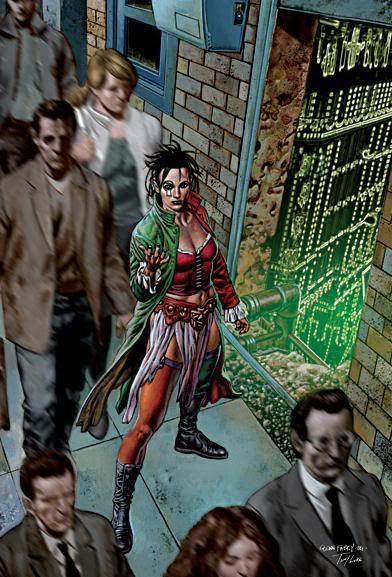
I got to "know" Mike Carey through his book: The Devil You Know. What sold me is that he is the scriptwriter for a lot of Lucifer graphic novels, Constantine and his newest graphic novel, pic above...Neverwhere, written by Neil Gaiman.
I have not read the Neverwhere graphic novel yet, but I did get a copy of his newest book Vicious Circle, having read and absolutely loved and admired The Devil You know. I have dabbled with a few of the Lucifer GN and I love Constantine.
Mike has also been nominated for an award - so I am really pleased for him. Especially as he is a UK writer, not just that, but he writes about London, about the UK and he calls it as he sees it. And he is taking the US urban fantasy writers by the scruff and shaking them around a bit. Simon R Green had better watch out too - there is a new kid on the block, and he is good.
Happy reading!
Thursday, October 05, 2006
Writing news
This is the link to it: http://www.fictionfactor.com/articles.html
I hope I won't get into trouble, but this is a sample article from the site:
Synopsis vs. Outlineby Vicki Hinze © 2003
There’s a lot of conflicting information out there on the difference between a Synopsis and an Outline. Many writers, particularly those in the early stages of their careers, find this confusing. So what is the difference?The short answer: A Synopsis is an Overview of the entire story from beginning to end. An Outline is a breakdown of the novel from beginning to end by chapter and scene.Let’s explore both a bit.
THE SYNOPSIS:A decent rule of thumb is 1 page of synopsis for every 10,000 words of manuscript. That's a guide, not set in stone. If you're smart, you'll find out what length synopsis the editor you're targeting prefers. Some like 1-2 pages, others want 25. So they're all over the board on preferences.In the synopsis, you don't get into deep details; again, it's an overview. You do want to focus on character and conflict, and establish the setting and tone of the novel by writing the synopsis in the same style. Now, on character, you must show that characters' goals and motivations. This is how you will, at the end of the synopsis, show that they have changed as a direct result of what they've experienced during the course of the novel. That character growth is what the editor/agent is looking for—to see if it's logical, rational, and believable—as a result of the story events. Those story events should be as a result of the characters' motivations and goals. That establishes their conflicts. Your main characters should have internal and external conflicts. These should be evident in the synopsis by what the character encounters in story events and how the character emotionally/physically/spiritually reacts to those events. Again, this is an overview of the novel. It always—even if you’ve done chapters to send along with it—starts at the beginning and progresses through to the end of the story holding all the key pivotal points in the novel.
THE OUTLINE:This is not an overview document, but an explicit one that breaks the book down chapter-by-chapter and scene-by-scene. Consequently, it is usually much longer than the synopsis. Here, you establish the events and rational (goals, motivations, and conflicts) of each scene and the scene resolution. (Note: There’s an article on the Elements of a Scene that could be helpful in the Writers’ Aids Library.)Scene resolution is NOT conflict resolution. Let's say the goal of the scene is to find out if a person has information on the major conflict of the story. In that scene, the characters interact and the scene concludes. The resolution of that scene is either the character wanting the major conflict information got it, didn't get it, or still doesn't know if the other character has the information. The scene, not the conflict, resolved.So in an outline, you work through the scenes, again including from the beginning of the book all the way through to the end, providing more detailed information on each scenes' content. (Which of course, includes goals, motivation, conflicts--internal and external.)Now do agents or editors use the terms interchangeably? Seldom. Do Agents or editors ever ask for both a synopsis and an outline? On occasion, yes. And when they do, they are after both the overview synopsis and the detailed outline.
© Copyright Vicki Hinze 2003. All Rights Reserved
~~~~~~~~~~~~~~~~~~~~~~~~~~~~~~~~~~~~~~~~~~~~~~~~~
Dr. Vicki Hinze is an award-winning, best-selling author who routinely shares her expertise at national writers' conferences, online, and through her writing guides. Her latest non-fiction book is ALL ABOUT WRITING TO SELL, from Spilled Candy Books for Writers. This 589-page ebook covers everything you need to know about the craft of writing, the publishing business, and the secrets to getting published. ALL ABOUT WRITING TO SELL is available at www.SpilledCandy.com as a download or disk.
Or you can visit Vicki's author site at www.vickihinze.com
Wednesday, August 30, 2006
To plagiarise or not to plagiarise, that is the question!
At the back of my mind I kept on thinking - "self, we know about this book...we've heard about it..." - so tonight, my first night online since the weekend, I googled it and lo! I was correct.
Kaavya Viswanathan is the young woman who duped publishers into publishing a heavily plagiarised book from various authors. Fans of Megan McCafferty who had written Sloppy Firsts and Second Helpings noted the similarities to Kaavya's books and immediately raised the alarm by contacting Ms McCafferty directly via email.
Kaavya who had secured a large advance on the book sales at first denied copying anything from Megan's work. Then a revised statement came out citing that Megan's work had been such an inspiration to her during her school going career that she had somehow retained some of the story, structure etc. and stuck it into her own work.
I googled some more and found some utterly astounding similarities, not just with Megan's work but other authors too. Check it out on the Wikipedia site!
I am stunned and amazed that someone could manage to get away with something like this. Even for a minute!
I feel sorry for Kaavya who has gone into retreat since the scandal hit at the beginning of the year. It must be hard to return all that money - not even sure if it got to be returned!?, I would think so, but what do I know!? - and admit to the world that your labour of love was more restructuring paragraphs of already published authors to make it seem like your own. Not just that but the movie deal fell through as did the follow-up novel which the publishers had signed a contract for. Can you say ouch!?
She must have felt awful when Megan's fans started picking up on all the similarities - trust me, they are hugely the same - she no doubt thought that NO ONE would ever sit up and take notice...never mind study the books and point out more than just one or two sections.
Shocked.
Did she think people were stupid? Its not like we live in the back of beyond where ideas do not get swapped daily via the internet, telephone, fax and word of mouth. And even in the back of beyond, you have to be pretty skilful to pull of a trick like plagiarising someone else's work...maybe a long dead author of a hundred or two hundred years ago, when admittedly it can be a "rewritten" piece of work...but ripping off well known authors with a huge fan base is just utterly stupid.... and she managed to get into Harvard?????
I sit here and think to myself that clearly I am doing the wrong thing by actually battling to get my own story out...maybe I can crip something like, I don't know...the previous Harry Potter movie...surely NO ONE has read about a wizard, his mates, his enemies. Yes, fabulous idea.
I'll do that.
Saturday, August 26, 2006
The Undomestic Goddess, Sophie Kinsella
 I picked this up from a colleague at work on Friday afternoon, started reading it on the train on the way home, later the day and finished it this morning after homework was completed.
I picked this up from a colleague at work on Friday afternoon, started reading it on the train on the way home, later the day and finished it this morning after homework was completed.It is an exceedingly funny book, the character, Sam, is real enough and you can sympathise with her, her situation, but you can see the ending a mile off.
High flying young lawyer, about to be made youngest partner in a large law firm in London...she gets the hibbie jibbies when she discovers a piece of paper on her desk which she had to do something crucial with...this leads to all sorts of complications, ending with her walking out on her job, her life, getting on the train and ending up in the back of beyond where she somehow manages to get hired as a chef and housekeeper for two very sweet people who are a bit tacky, having come into a lot of money through business dealings. Comedic confusion ensues as Sam has no idea how to cook, clean or iron or even Hoover...so she is stuck and some of the situations are hilarious, laugh out loud funny. She however meets the gardener, Nathanial who is devastatingly handsome and she gets naughty thoughts about him...well, need I say more?
I can very easily see this be turned into a rom-com movie starring someone like Kate Hudson, Clive Owen and Matthew Mcwhatisface, he of the bongo drums fame.
A fantastic book to sit back with, to forget the mundane and be swept away with other people's lives. Enjoyable and easily read. If only all of us could walk out of our day jobs, into the countryside and not only not have to worry about money or any bills, but to find our dream jobs...sighs and goes off to check her lottery ticket.
Monday, July 03, 2006
Working for the Devil - Lilith Saintcrow

Dante Valentine's working relationship with the Devil began on a rainy Monday. Dante's a licensed Necromance, one of the best ever to survive training, and she's got an emerald embedded in her forehead to prove it. That's why the Devil sends his minion to hire Dante to kill Vardimal Santino, a fugitive demon. As Dante points out, Necromances don't kill people, they bring them back; or at least their ghosts. But turning down Lucifer isn't something you do if you want to stay alive, and besides, it turns out she's got a score to settle with Santino. Desperate to track down an enemy she can't find, Dante is bonded with a demon familiar she doesn't trust and a small band of psychics who seem almost as determined to help her as she is to refuse their help. The thing is, Dante doesn't need friends, she needs a miracle. Because the first time Dante Valentine met Santino, she almost died.
I found a copy of the book at Forbidden Planet, read the back once...then again. And bought it. How could I not!?
And let me say, I am not disappointed. And I am even happier to learn that there are more books on the way from Ms. Saintcrow.
She has created a funny warm hearted heroine who seems very tough, very capable and hilariously funny. Dante has a good background, loads of things hinted at which could be used in the next few books. She is convincing as a person, even if she is a Necromance, and not a section of "magic" which usually gets written about - and I am not talking Garth Nix and Abhorsen here either.
The story is set in the future. A lot has happened - magic is real, as is angels, demons, the Fallen, vampires, necromances, psions and other paranormal types. It works - you do not get overloaded with needless information, very few pieces of information get repeated (for example, you learn that Dante can handle herself in a tough situation, unlike the Merry Gentry books by LKH, where you constantly have to hear how small she is, how tiny her hands are, how pretty she is or how macho her men are) - Dante is Dante - she is capable and eventhough she has been thrown in the deep end with a familiar, from Lucifer himself, she draws herself up and does what she has been told/asked/cajoled into doing.
I would really recommend the book. If you are after a "fresh" voice, a strong female lead character and a hugely amusing cast of supporting characters, do give it a whirl. You will not be disappointed!
Wednesday, May 31, 2006
Tim Severin - Viking, Odinn's Child
And adventure it is!
Viking: Odinn's Child is the first book in a trilogy (the other two are already out, in fact, I already have book two waiting for me) and it follows the adventures of Thorgils Leiffson.
Our story begins in the year 1001 and the toddler, Thorgils Leiffson, son of Leif the Lucky and Thorgunna, arrives on the shores of Brattahlid in Greenland to be brought up in the fostercare of a young woman - Gudrid. Thorgils is a rootless character of quicksilver intelligence and adaptability. He has inherited his mother's ability of second sight and his destiny lies beyond the imagination of those around him. Virtually orphaned, he is raised by various mentors, who teach him the ancient ways and warn him of the invasion of the 'White Christ' into the land of the 'Old Gods'. Thorgils is guided by a restless quest for adventure and the wanderlust of his favoured god, Odinn. His fortunes take him into many dangerous situations as well as to the brink of death by execution, in battle, disease and shipwreck...Packed with wonderfully reimagined Viking sagas and adventures, and fascinating and unique characters, Viking - Odinn's Child gives historical novel writing a new dimension. - This from FantasticFicton.com
What I thoroughly enjoyed and am still enjoying as I have not finished the book - yet - is how beautifully it is written. The author, Tim Severin clearly loves his subject matter - being a bit of a historian, traveller and adventurer himself - and whilst it is packed full of interesting information that fills your head with the sounds, smells and t he stark reality of living in an age as violent and as exciting as this, he manages to make it not become tiresome. He is the master of showing and telling, all at once, but with such great skill that you only realise after the fact that you have just learned how they spent Christmas - Jol - in the Orkneys and what kind of ruler their king was, etc. Cunningly done and with great pace.
I can't wait to read it all - in fact, I have been to visit Tim Severin's website and I am delighted to learn that he is a true gentleman adventurer. He has several other books out, non-fiction, in which he travels the world, examining the stories and facts behind classical stories such as Jason and the Golden Fleece, Ulysses, Sinbad, etc. And that he has produced films and documentaries for the Beeb and National Geographic. Very impressive!
Happy reading!
Sunday, May 07, 2006
Anansi Boys - Neil Gaiman

Och. The sheer jealousy this man's writing evokes in me!
Hubby bought the book for me as a present and it was such a treat to sit down and read it. One of those books - yet again - that made the train journeys just go so much faster!
Once again, Mr. Gaiman, decides to populate the world with gods, their offspring and all their hilarious and over the top wonderful adventures.
The backpage blurb:
God is dead. Meet the kids.
When Fat Charlie's dad named something, it stuck. Like calling Fat Charlie "Fat Charlie." Even now, twenty years later, Charlie Nancy can't shake that name, one of the many embarrassing "gifts" his father bestowed -- before he dropped dead on a karaoke stage and ruined Fat Charlie's life.
Mr. Nancy left Fat Charlie things. Things like the tall, good-looking stranger who appears on Charlie's doorstep, who appears to be the brother he never knew. A brother as different from Charlie as night is from day, a brother who's going to show Charlie how to lighten up and have a little fun ... just like Dear Old Dad. And all of a sudden, life starts getting very interesting for Fat Charlie.
Because, you see, Charlie's dad wasn't just any dad. He was Anansi, a trickster god, the spider-god. Anansi is the spirit of rebellion, able to overturn the social order, create wealth out of thin air, and baffle the devil. Some said he could cheat even Death himself.
Returning to the territory he so brilliantly explored in his masterful New York Times bestseller, American Gods, the incomparable Neil Gaiman offers up a work of dazzling ingenuity, a kaleidoscopic journey deep into myth that is at once startling, terrifying, exhilarating, and fiercely funny -- a true wonder of a novel that confirms Stephen King's glowing assessment of the author as "a treasure-house of story, and we are lucky to have him."
I remember reading Neverwhere just before moving to the UK and somehow this slightly askance universe really made sense to me of what London represented. I became a big fan of Mr. Gaiman after this although, ashamedly, I will say that I have not read any of the Sandman graphic novels.
Anansi Boys is brilliantly written. His style of writing is so tongue in cheek and keenly observed that it can be written about any of our families'. Siblings you don't really want to have, but they stick nonetheless, embarrassing moments your parents pushed you into and you believed them because they would't lie to you, would they?
The main character, Fat Charlie had all my sympathy in this book - his life was invaded by a brother he didn't know he had called Spider, who, for all intents and purposes had inherited their dad's powers. Spider pretends to be him, blackmails his boss, charms his fiance and this is just the start of it all!
Such a well written funny book - and yes, I am being repetative here as I don't know what else to say other than "go and buy it, borrow it, but read it!".
Wednesday, April 12, 2006
Nightlife, Rob Thurman

A few weeks ago I was lucky enough to have lunch with wordweaver and we chatted away for ages over remnants of pizza and juice at a Pizza Express just off Museum Street in London. I had the afternoon off - I know, I am the luckiest girl! - and after we hugged one another goodbye I set off to visit Forbidden Planet on Shaftesbury Avenue to have a "look around" - my intention was to keep my cards firmly in my pocket and not to succumb to temptation.
**giggles**
Well, I failed. I came away with two books for hubby, and an armload for me. One of which was Nightlife by Rob Thurman. I was a bit tentative, thinking it was going to be a bit rubbish, but for a fiver, I could risk it.
And, once again, I was proven wrong. What a good read by the first time novelist Rob Thurman - www.robthurman.net - and a definite talent to watch out for.
The novel surrounds Cal - Caliban - and his brother Niko. They are on the run. From monsters, grendels, who are after Cal. You see, he is an interesting mixed breed of monster and human, the first ever hybrid to live and survive after a breeding...and they want him back...what for isn't clear at first. They had him, when he was younger, they snatched him away but he managed to escape and he came back to find his brother Niko waiting for him at that exact spot he disappeared. Niko turns out to be a blond Jet Li, scarier than Van Damme and meaner than Chuck Norris on a bad hair day. Together with Robin Goodfellow they face the grendels, they meet up with a loup garou, they shake down a bogart and fight a troll. A lot, a lot! happens in this book.
I suppose, it could almost be aimed at the young adult market but then...adults wouldn't read it and eventhough it is written from Cal's perspective, it isn't a childish book. It deals quite maturely with parents gone wrong - the mother is a drunk and drug addict - how family genuinely matters in times of need and how far you are prepared to go to protect those you love.
I genuinely hope Mr Thurman writes another one as he has created a paranormal culture world in New York City and he could easily set off another novel there.
I give the book....four book stars!
Jo Beverley - Meeting and greeting and signing
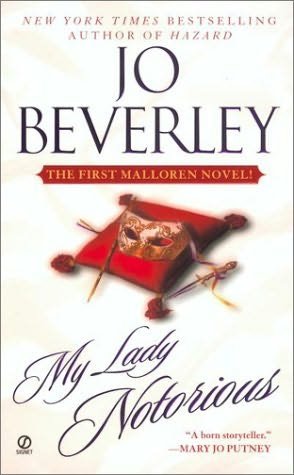
About a year or so ago, I came across this little gem in the Waterstones on Piccadilly and thought that I would give it a read. It sounded enchanting and in the same vein as the Georgette Heyer books from my teenage years.
I read it and loved it and wrote to the author, Jo Beverley, to tell her how much I enjoyed reading a historical romance and how - once again - it has opened my eyes to the possibilities within this genre. What helps is that Jo can write. Her characters are funny, bold, brash, silly, sweet, brave, handsome, pretty, sexy...the works.
This is a brief idea of the book:
To save her sister, Lady Chastity Ware hold up a coach. Unfortunately, instead of containing an elderly lord or a wealthy merchant, it holds Captain Lord Cynric Malloren, bored after time at home recovering from sickness. To her exasperation, he insists in helping her, regarding the whole thing as an adventure.
While evading the villain who seeks to snatch her sister's child, and the military raised to search for all of them, Chastity and Cyn fall deep in love. But Chastity is a ruined woman whose father will never let her marry a Malloren, and Cyn's brother, the formidable Marquess of Rothgar, will surely not permit such a disastrous alliance.
What was genuinely nice is that Jo emailed back and we have had an on-off email correspondence going for a few months now. On Monday I got an email from her pointing out that she will be doing a signing of her new novel at Murder One on Charing Cross Road in London, if I wanted to attend.
Having not ever been into Murder One, I thought yeah, that is an idea so off I toodled and found her firmly enthroned - complete with a pen that lights up when she writes - in the "romance" section of the bookshop. It was a revelation. There were four of us, excluding the shop assistant who looked after that section of the shop, and then of course, Jo who had us in gales of laughter at her research, her characters, etc. What a fantastically funny and witty lady who is, apparently huge in America and Canada, whereas I don't think she is that well known in the UK. With in excess of 29 books to her name she is not only prolific - did I mention I was jealous? - but also an extremely well read and genuinely interesting person. She was holding court, when I left, having had my copy of Lady Notorious signed - neh, neh, neh - and with promises extracted from the shop assistant that I would be back to visit.
I must admit, as previously when I did the review of the Alexander Potter book, that I am ashamed of my own preconceptions on this genre in general. Having grown up with the soul-sucking Mills & Boon novels from the 70's and 80's I thought I had been put off Romance for life. Today's visit, and reading these two gems, has definitely changed my mind. In fact, I would go as far as say that there had been a bit of an "about face".
The genre has expanded tremendously - these days it isn't just bustier rippers, historical romance and pink fluffy modern girly books that line the shelves - they have expanded into a huge range; thanks to Laurell K Hamilton and her ilk, they now have books that cross over into urban fantasy (vampires and werewolves) into thriller (spy novels for girls) into supernatural/paranormal....it is fantastic!
A new reading genre has opened to me - here's hoping the hubby can cope with the more books that will be bought!
Watch this space....
Tuesday, March 14, 2006
So many books, so little time
I can wax lyrical about a chapter, a sentence used to describe something that really resonates but I have found that sometimes, when I do, and I try and explain it, I get these "dead fish" eyes looking at back at me from the people I am talking to. And I realise that not everyone can get carried away by a book, be it a romance, a chick-lit book, a sweeping historical novel spanning generations, a science fiction book of the improbable future or a fantasy book with swords, sandals and beautiful damsels and handsome heroes.
I remember the easiest way to get my mom to sleep on a Sunday afternoon was to hand her a newspaper whilst sitting on the couch. She would be - guaranteed - gone in a matter of five minutes or less. She hated me reading. Always thought it was a waste of precious time. I could be out there, doing other things. Like cooking and cleaning and helping her with her many crafts. I suppose, I might have been better off learning these things as I am not a good house keeper at all; I am a very good cook, but that might be genes and the necessity to eat playing a big role there...and I have brilliant ideas for making things...just not the ability to.
But what I do have is an enduring passion for the written word. My prized possession at the age of fifteen was a leather bound copy of Shakespeare's works. I remember sitting in the back of our Toyota Cressida driving down to the coast for our annual holiday, hugging the book to me, touching it and opening it at random and reading the Bard's words to myself and thinking that no one could write better than that. Where other kids that age would run a mile reading his plays, I lapped it up. I was a geek, I admit it, but I was a geek with an imagination and a fantastic vocabulary.
I forget the real point behind this blog...but the pic and the title says it all: So many books, so little time! Or, as a friend who recently got Sky said: so many channels to watch, not enough eyes. I rest my case.
Sunday, February 26, 2006
Storm Front - Jim Butcher

Magic and wizardry meet hardboiled detective fiction in this genre-blending debut novel from Jim Butcher.
Harry Blackstone Copperfield Dresden is a wizard for hire (he's in the Yellow Pages, under "Wizards"). He doesn't have a lot of competition: in fact, he's the only openly practicing professional wizard in the country. At the turn of the millennium, popular awareness of the paranormal has skyrocketed (aided by events like the Unseelie Incursion of 1994, when the entire city of Milwaukee vanished for two hours), but most of those with paranormal skills still prefer to keep their abilities under wraps.
Business is slow. So when the police department, which occasionally calls Harry in to consult on cases that involve the paranormal, asks him to assist with a particularly gruesome double murder that may have been accomplished by magic, he can't afford to say no -- even though it's immediately obvious to him that black magic is involved, and that the mage responsible is very powerful indeed.
The above is courtesy of the SFSite.com website.
I have seen the books around and were hesitant in buying the first one. I thought that it would be as mindstonkingly boring as the Laurell K Hamilton books, the Anita Blake series but found - happily - that I was wrong. This is much better written and the author, Jim Butcher, has taken great pains in creating a genuinely nice main character who is just that little bit unpredictable but completely understandable to snare you and draw you in. Unlike the Anita Blake or Merry Gentry novels, there isn't thirty pages of sex at one sitting to get through, in fact, there is no sex in this, but a lot of sexy and a lot (a lot) of action and tongue in cheek funny stuff.
It wasn't until I visited the Jim Butcher website that I found out they are currently shooting/have completed shooting the first episode (or entire series, I didn't read all of it) of The Dresden Files, which is based on Harry's adventures. Smashing stuff - and what is really cool is that they have an English actor playing the part of Harry, but with an American accent. His name is Paul Blackthorne (what a fantastic name, right!?). So, it looks good.
I am looking forward to reading the second book in the Dresden Files series which I picked up today.
Wednesday, February 08, 2006
The Borgia Bride by Jeanne Kalogridis
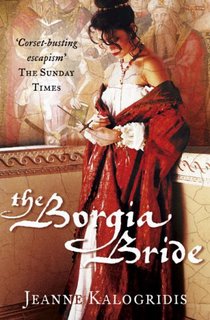
Continuing my historical novel romp, I started reading The Borgia Bride this week. It was one of my birthday presents which I had asked for on my "wishlist".
Ye gods, I am utterly loving it.
What I resent though is the fact that on the cover it is cited as "Corset Busting Excitement" by the Sunday Times. Why is it, when a man writes a historical novel it is called a historical novel (even if there is sex scenes every few pages, raping and pillaging), but when a woman writes one (there has been 2 sex scenes and I am on page 300-odd) it is called a bustier-buster? Anyway, I suppose it makes the books sell...either that or the chap/ette from the ST didn't actually read it and went on the blurb on the back!
Ahem. I am not finished with it yet - I reckon two or three more trainjourneys into town and back home should do it. So, in the meantime, I copied this across from http://www.lovereading.co.uk/book/200
Breakdown of the novel:
Italy 1492 Pope Alexander VI is elected. And so begins the Borgia reign of terror.
Alexander murders, bribes and betrays to establish his dynasty. No one is immune. Rome is a hotbed of accusation and conspiracy. Every day, the River Tiber is full of new bodies.
Sancha de Aragon, daughter of King Alfonso II of Naples, arrives in Rome newly wed to Alexander’s youngest son, Jofre. Their marriage protects Naples against the ambitions of the French King Louis and gains Spanish support for the Borgias. But Rome is very different to her beloved Naples.
The debauchery of the Borgia inner-circle is notorious: every lust is indulged and every indiscretion overlooked. Sancha is no innocent: she possesses an indomitable spirit which allows her to survive in the snake-pit, but her ancestors once rivalled the Borgias in cruelty and Sancha’s greatest fear is that blood will out.
Lucrezia Borgia’s vicious jealously stings Sancha at first, but gradually the two young women develop a cautious friendship. Lucrezia, adored by her father but used ruthlessly as a political tool, seems deceptively innocent and sympathetic, and their bond strengthens when Lucrezia is married to Sancha’s treasured brother, Alfonso.
But when Sancha falls in love with Cesare Borgia, her husband’s enigmatic older brother, she has no idea of how bizarre and internecine are the family's true ties. Alexander is rather more than an indulgent father; Lucrezia not the innocent she appears; and Cesare’s ambition burns wildly. The only safe relationship with the Borgias is none at all: as Sancha, her brother and Naples are soon to discover...
Thus far, I must say, we have another very strong female heroine. I look forward to seeing how the story developes!
The paid companion, Amanda Quick
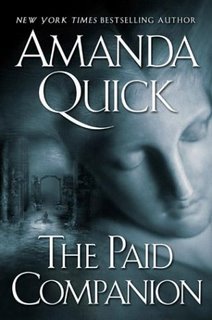
I found this beauty in the crime section in the Waterstones on Piccadilly and because I am a sucker for historical novels - okay, read, Liz is a sucker for any book that piques her interest - and loved the idea of an English nobleman deciding to procure his fiance through an agency that supplies paid companions to the elderly ladies...
Of course, things go "wrong" and he discovers that the young lady he has chosen is full of sass, is clever, and has strong morals and is also, accidently, quite lovely and is hailed as an original by the High Society circles they mingle in. The reason for his new "fiance" is a simple one - she is to be a distraction whilst he sorts out new business investments...and you can immediately tell that this is a lie, right!? Right! He is in fact after the murderer of his uncle and his companion / fiance turns out to be quite capable of helping him out.
A fantastically fun book - the characters are genuine and you really like Eleanora who is funny, witty and is not at all a wallflower.
I really enjoyed this book and have subsequently discovered that there are other novels written by this author.
Oh, happy days!
Thursday, February 02, 2006
Tell me what you see, Zoran Drvenkar
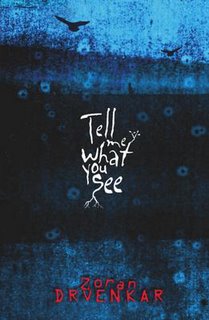
From the publishers' website:
Berlin. The dead of night. Sixteen-year-old Alissa and her best friend Evelin make their secret Christmas pilgrimage to Alissa's father's grave. In the graveyard, Alissa falls through thick snow into an underground crypt. Searching for a way out, she discovers something else: out of the lid of a small coffin coils a strange black plant. Drawn closer, Alissa sees its roots embedded in a young child's heart. This chance encounter sets off a chain of nightmarish events that throw her life into turmoil. Haunted by angels, stalked by her ex-boyfriend, only with Evelin’s help can Alissa reclaim her sanity and discover the truth about her frightening new gift.
I bought this on Tuesday and finished it on Wednesday evening - it was that readable and that compelling.
I found Mr. Drvenkar's work utterly riveting and the prose, translated into English from German, a revelation in style. He conveyed so much atmosphere with few well chosen words. And he didn't skimp on being lyrical.
It is quite a grown up novel - it deals accurately and beautifully with friendships and relationships between friends and family. You really feel for the main character, Alissa the winter child and Evelin, the best friend. And by grown up, I don't mean x-rated (although he deals beautifully and maturely with lesbianism and an ex-boyfriend who is the loving one) but grown up in the sense that he tackles issues pertinent to his two girls in the book and makes them see it through and be the heroes in a very realistic way.
I don't really know how to describe the novel other than saying it is an intimate visit during a period in a young girl's life where she goes through something very strange - I enjoyed it thoroughly. I doubted her sanity, thinking that he was going to cop out and have it all be in her head ... that she was insane... but he had tricks up his sleeve and pulled out a whopping end.
I would recommend it highly - four out of five books!
Saturday, January 28, 2006
Re-reading an old favourite - Greenmantle, Charles de Lint
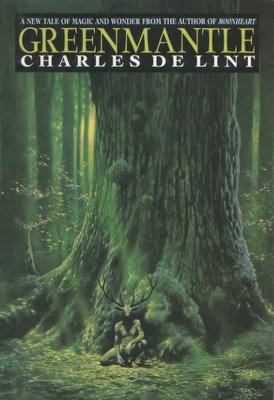
Charles de Lint is one of my favourite authors. He is a musician, writer and artist. I have probably got every single one of his books - not that I am obsessive or anything!
I picked up Greenmantle this week to re-read as I don't have anything new to read, having spent my allowance on presents for friends (send free books, in other words!).
I can only one day dream of being able to write as well as he does. He writes what can be termed "urban fantasy" - every day "normal" people happen across magical beings and suddenly, their world and their perceptions are turned upside down.
Greenmantle is no different.
It tells the story of a retired Mafia soldier - Valenti - who leaves the business behind and buys himself a love house in the woods. His neighbour turns out to be a young single mother called Frankie who has a fourteen year old daughter by the name of Ali. Frankie also has a nasty ex-husband who is after the few thousand dollars she had won on the lottery and he gets thrown into the mix of characters...it is about crime, mafia, music, magic, and believing in the impossible.
Ahem.
Meanwhile things are stirring in the forest - beautifully haunting music is played on a pipe, deep within the forest. Ali and Valenti go in search of it and find something no one expected - an entire village of English people who have returned to the old ways of nature worship. The young boy who is the piper calls the "mystery" to him - a large beautiful stag, that represents both the Green Man, Pan and Cerunnos, all at once. The music awakes within those who hear it, whatever they bring to it - be it anger, loss, pain, lust. It is powerful stuff and the first time I read it I was completely taken aback by the things written and said in there - the fact that Christianity is a fledgling religion, that it stole and borrowed from other religions to become what it is today...that our imagination is indeed strong enough to create beings of mystical power and to enable them to roam the world.
It is an eclectic book - beautifully written with so many questions being asked by all the characters that it is, in retrospect, not sumat you want to pick up and flick through and skip paragraphs and pages "cos they don't talk too much in this, do they?".
It is a fantastic read and for those of us with a bit of a New Age slant, it goes down very well. Heavy decisions are made by the characters in the book and they are all genuinely interesting people with faults and failings which makes you feel for them when they succeed or just crumble when you realised they did the wrong thing.
Good fun - give it a whirl.
And now for something completely different...!
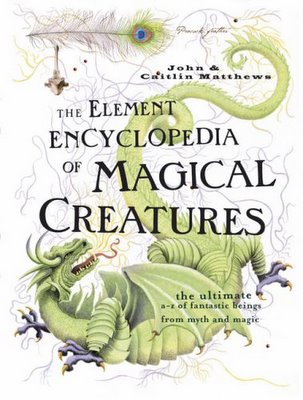
I am a sucker for anything to do with myths and legends, magical and mystical creatures. The above book was sent to me as the Editor's choice from my book club. I was thrilled.
This weekend I will be dipping into said treasure trove of creatures - who knows if inspiration might strike! For instance, from one of my other books in the same vein, I learned that Hagrid actually means giant in one of the Germanic/Scandanavian languages...very cunning Mrs. Rowling!
This is from the creature book itself - only one of thousands of entries:
Achelous
In Greek mythology, Achelous was a river
god who took three different shapes when
he chose. He could take the form of a bull, a
speckled serpent or a bull-headed man, like
the Minotaur. He wrestled with Hercules
for the hand of Dejanira and, while in the
latter form, lost a horn. The blood that fell
to the ground from the horn became the
Sirens, while the horn itself was discovered
by Naiads who took and filled it with flowers
and fruit. Classical myth tells us that
Achelous’ horn was then presented to
Plenty (Amalthea) who made it her cornucopia
(the ‘horn of plenty’).
How can you not be excited about having such an invaluable tool at hand? Yay for Thorsons Element for publishing a unique book!
Sunday, January 15, 2006
Seeking whom he may devour - Fred Vargas
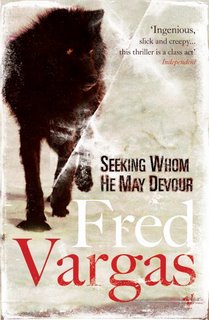 I couldn't wait to start reading this book.
I couldn't wait to start reading this book.The premise is fantastic - Disturbing things have been happening up in the French mountains; more and more sheep are being found with their throats torn-out. The evidence points to a wolf of unnatural size and strength.
Which of course leads us to the concept of it being a werewolf and I am a sucker for anything remotely lycantropic or anything to do with wolves. They are our primal fears embodied!
Its a slim book, I thought to myself, a quick easy read. Phsaw. How wrong can one be?
I started reading it and I was swept away on a slow, scary ride of a thriller plotted well and written in beautiful prose.
This book had me sitting outside my house - after I forgot my keys and had to wait for hubby to come home in the evening - on the doorstep, in the moonlight, squinting at the pages. I then looked up and noticed the moon.
It was ghosting through the sky under cover of whispy clouds and it was oh so very very dark.
And I was reading a book about wolves attacking people and sheep. I was petrified. I closed the book and put it back in my bag. What, I kept musing to myself, if it was real? What is that sound? I jumped it in alarm. I sighed in relief. It was hubby coming back from walking the dog and it was the dog's nails clipping on the pavement.
Shudder.
It is a tense, taughtly written piece of fiction with fantastically interesting characters who exude mystery and charm. It is set in France in modern times but in a very rural area where, in my mind, anything can happen. Myths and legends still abound and people live close to the land, where paganism and folklore live side by side with going to Mass, where superstitions are rife and where people can be whipped up into a lynch mob to hunt down a suspected werewolf - an inside out man - at the mere hint of the thought of one being amongst them.
I would really recommend this book to anyone who enjoys well written fiction. The end is a scorpion's sting and I didnt' see it coming at all.
Well done, Mme Vargas. I now look forward to reading The Three Evangelists!
Be carefull what you wish for - Alexandra Potter
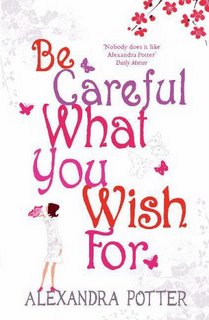
A guilty secret. I hate chick-lit. I hate these little pink fluffy books on the bookshelves being hailed as best-sellers. It makes me want to shout and scream as there are other "real" authors out there who deserve to attention these books get.
And then, after some retrospect, I realised how unfair I am being. Chick-lit caters to a certain group of women in market. And why shouldn't their needs be fulfilled?
Many people out there who read "serious" novels in the "acceptable" format of literary books, crime novels and thrillers, look at other writings in different genres and call them "fluffy" "not serious books". Science fiction and fantasy authors have been fighting for years against the stigma of their work not being called "real". I sometimes wonder if it is a case of sheer jealousy? Those who can't...turn into bitter jealous types who refuse to acknowledge hard work.
The blood, sweat and tears to get that manuscript out is as real as any other author struggling to get his or her own work out, no matter the genre. I will NEVER, I hope and pray, be nasty about other authors, ever again, no matter the genre.
I picked Be careful what you wish for up fromWH Smith as an offer when I bought Fred Vargas' Seeking whom he may desire. I wanted to see, for the first time in absolute years what was going on in the chick-lit genre. I girded myself and reached out to the bookshelf with a quavering hand and picked it up, hastily paying for it and hiding it in my handbag.
And, I am glad I did buy it, in the end. It is a rollicking good read. You immediately like the main character Heather and can identify with her mishaps, her job, her own insecurities and how utterly hilarious some of the situations are she gets herself into. This is far better than I expected and I applaud the author wholeheartedly for giving a real character who interacts genuinely with her family, friends and two men her life.
This is the synopsis from Amazon:
A sassy romantic comedy to delight fans of Sophie Kinsella, Freya North and Helen Fielding. You couldn't wish for a better book! 'I wish I could get a seat on the tube...I hadn't eaten that entire bag of Maltesers...I could meet a man whose hobbies include washing up and monogamy...' Heather Hamilton is always wishing for things. Not just big stuff - like world peace or for a date with Brad Pitt - but little, everyday wishes, made without thinking. With her luck, she knows they'll never come true...Until one day she buys some heather from a gypsy. Suddenly the bad hair days stop; a handsome American answers her ad for a housemate; and she starts seeing James - The Perfect Man who sends her flowers, excels in the bedroom, and isn't afraid to say 'I love you'...But are these wishes-come-true a blessing or a curse? And is there such a thing as too much foreplay?
I would, out of five bookish stars, give it...four book stars.
It also taught me not to pigeonhole books. Now, all I have to do is overcome my aversion to science fiction books!
Sunday, January 08, 2006
Long Way Round - The book, not the TV show

I didn't watch The Long Way Round when it aired on TV last year - I thought "yeah, yeah, another publicity stunt by two actors wanting to make yet more money".
But, in the end, at a loose end as what to buy hubby as a stocking filler, I opted for the book written by Ewan and his mate Charley. I didn't think it would be anything special but since it had to do with motorbikes, leatherclad boys and travelling the world, it would the stocking and be an interesting thing to chat about.
Both hubby and I are ex-bikers (I was the pillion as my own bike escapades ended with me selling my bike - Black Betty (eventhough she was purple) to friends of ours as her souped up engine was too much for poor me to handle) and I thought it would be a nostalgic way to look back on our crazy days of camping out with other insane bikers in the freezing cold or the boiling hot.
Hubby finished the book, loving it, laughing out loud sometimes and out of curiosity I picked it up and was instantly immersed in the two boys' adventure. I admit to being very wrong about it all. They weren't just out to make another quick buck. They were scraping money together to do what they have dreamed of doing for years - travel around the world. It struck a chord. I felt sorry for them as they ran around trying to do get funding for this trip, eventually agreeing to do a tv show just so that they could make the trip.
I sit back, having finished reading it last week Monday night and can't help but feel that this is something I would love to do myself. I told Mark and he looked at me as if I had just sprouted another head. Yes, right, he said, burying his head in playing Splinter Cell on the Playstation, clearly thinking that I had a fever.
Isn't that what books are supposed to do though? Make you want to run out and do things?
I followed the lads on their journey, loving their tongue in cheek way of writing, meeting hundreds of people through them, seeing that there are very few strangers out there, just potential friends. I felt sorry for Ewan though as he was being recognised wherever he went, even in Russia. The Kazaks told him blatantly that Moulin Rouge was not their favourite movie, not his best either. It was very funny. I think it took him aback as it just showed how far into the world one has to go to be anymous.
Charley was very funny - he was the angry one a lot of times, shouting at the back-up chaps and generally having fits about things. Which surprised me a bit as I thought Ewan would be the one throwing the prima-donna fits. Although he did, according to Charley, going into sulks and then being fine the next minute. Which amazed me even more - aren't us women supposed to be the ones with hormonal problems?
They had a rollicking time - eventually clocking that this journey which had started out so well, had turned into a schedule keeping malarky and once they relaxed, things went tonnes better. They travelled and saw things very few Westerners get to see, ever. I take my hat off to their cameraman Claudio who travelled with them and filmed them and their escapades. He was indeed the unsung hero of the book.
I think I will buy the dvd for Mark - of course - as it would be interesting to equate what was written in the book to what we saw on that.
Charley is currently doing the Paris to Dakar rally - but had apparently managed to break both his hands and is now merely travelling along as back-up to the other two chaps in the team. I am not sure what Ewan is up to but either way, I will always be a fan of them now and will always dream - even more - of going to farflung places and meeting interesting people. And have an Adventure.
Cinnamon City - Miranda Innes
 I love travel writing books - it is a weakness, I will admit to. I love being carried away by other people's trials and tribulations whilst feverently wishing that it was me there, spending money on a home to be made beautiful, a trip to enjoy to the last...they are fantastic journeys, better than made-up fiction.
I love travel writing books - it is a weakness, I will admit to. I love being carried away by other people's trials and tribulations whilst feverently wishing that it was me there, spending money on a home to be made beautiful, a trip to enjoy to the last...they are fantastic journeys, better than made-up fiction.Cinnamon City was a book I was looking forward to reading when I first spotted it in Ottakars in Greenwich on one of our many coffeebean buying trips to the market there.
I finally bought a copy just before Christmas, started reading it haphazzardly and then putting it aside in favour of one or two other, more pressing books, and I am glad I did. This is not a book to sit down and read in one go. It is not for the feint hearted.
Poor Miranda and Dan's trials really had me shaking my head thinking that this was never going to work.
They were lured into buying a broken and sad riad in Marrakech. She relates all their troubles with heartfelt anxiety and worry whilst lyrically giving an account of this magical city, its people and the genuine friendships they had formed with their (eventual) manager, neighbours and workmen.
I had to grin and laugh, knowing how chaotic building projects in Africa can go and then shape up magically in a blink of an eye. She and poor Dan worried fretfully as suddenly, everywhere they looked there was chaos, mud and water and the plumbing didn't work. Their palace had been turned into a tip. It was terrible and they out of money and had to borrow from friends and family until a flat could be sold in Brighton. Thanks to perseverance and the good fortune of having hired the right man for the job, it all came together beautifully in the end and apparently, the end result, like the book, is a work of triumph.
It is a genuinely an enjoyable book and hopefully I will be able to visit the now finished palatial and beautiful riad to take in all I had read about. Their website www.marocandalucia.co.uk is a very basic one, showing some of the pictures in both their riad in Morocco and their home in Andalucia - both of which are up to rent throughout the year, prices on the website!
Wednesday, January 04, 2006
And today's lesson is...plot

Dan Brown. The man who has sold more books worldwide than any other author…his books have only been outsold by the Bible. Which is sort of funny, if you think about it.
I was chatting to a colleague at the watercooler – as you do – and he asked me what I did over the holiday…so I mentioned that I got quite a bit done on my novel (brave move for me as I try not to talk about it too much as it used to be an embarrassing thing….are all budding authors like this?). I digress. Young colleague, lets call him YC, to make things easier, and he asked me firstly:
“Are you writing a Mills & Boone romance?” at which I burst out laughing and said no, not quite.
Then he looked at me keenly and said… “Are you writing a Dan Brown novel?”
And I laughed even more. And said no, my writing is MUCH better than his. Which led – amongst other things - to the conversation about the sale of his books and if he is a good writer or not…
Now, I think he is a fantastic writer – he has the world wrapped around his word processor.
I admit this with a blushing face as I know my prose is better than his but what he hit upon was an amazing plot and a public willing to believe all he wrote – I am talking about the Da Vinci Code here, by the way. A hugely successful book which, like JK Rowling’s books firstly started selling by word of mouth, then the media picked it up, the marketing machine kicked in and it all just steam rollered it into a book so talked about and controversial that it had the Vatican up in arms, families not talking to one another….and all of this hype spawned off-shoot books about the REAL Da Vinci Code, including programmes about church organisations, the Templars and Roslyn Chapel in Scotland!
Which brings me to the real crux of this blog – you can be a rubbish writer, but if you have a fantastic plot and you can manage to weave your story together to make it plausible so that you turn people’s heads then you are a successful writer. As that is what writers do – create something altogether real and plausible and make you wonder what if…
We discussed the Dan Brown phenomenon in our writing class last year and our tutor maintained that even though it wasn’t the most literary thriller in the world, it had all the ingredients that made it a best seller – fast paced plot, an attractive hero, a plausible heroine, conspiracies, scary baddies (what is more scary than a religious fanatic backed by an even scarier Vatican sanctioned order), yet more conspiracies…he admitted rightly that he read two pages of the book and had to throw it across the room as he couldn’t stomach the bad writing. We questioned him as to how it got past the editors if it was that bad and he circled us back to the plot, the thrill of the ride you get to go on with the characters and how, if you are clever enough at illusion, you could have a rollicking time writing your novel because you know so many people out there would be loving it, just because it is in places far-fetched! And face it, even if you aren’t a conspiracy theorist who doesn’t love a good cover up!?
It was a valuable lesson that gave us pause as we were quite happy to write it off as rubbish (more out of jealousy than anything else) but the core role is – plot.
This is a bit of blurb from the Writing section of the BBC website
In a nutshell, a great plot will be one which appears to develop inevitably, features credible events, and resolves itself in a way which appears to be a natural consequence of the chain of events you've inflicted upon your characters.
And that is the lesson for today.



